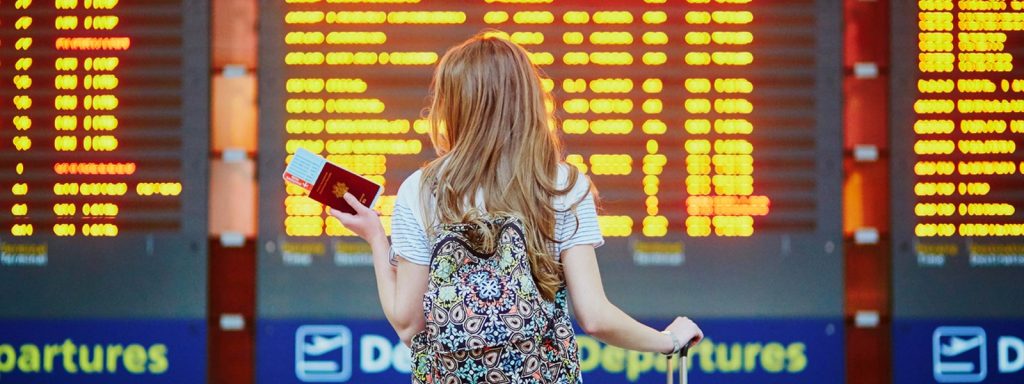
March 4, 2022, by sustainablenottingham
Trying to travel as sustainably as possible by Ryan Neal
Over the past few years, I’ve been making a concerted effort to reduce my carbon footprint. I’ve replaced my meat and dairy diet with a vegan one and I swap my car keys for a travel pass wherever I can. My kitchen cupboards are full of environmentally friendly products, and my supermarket commute is now a walk to the local zero waste shop. But one aspect of my lifestyle still stood out as being carbon intensive.
According to a United Nations World Tourism Organisation report, tourism is responsible for 5% of all energy-related CO2 emissions.[1] Three-quarters of that comes from transportation. For me, travel is a great passion and one I couldn’t quite bring myself to forgo – especially since my family live outside of the UK. For a long time I struggled to reconcile my travel with my sustainability values.
Below are a few tricks I’ve learned to limit the carbon impact of my travels. I’m aware that this comes from a position of privilege – I’m lucky to have a stable, well-paid job that allows me to spend a little extra to preserve my values. Some of the advice below will simply be unachievable for some members of our community and that’s okay. These are merely some options to consider.
Avoid airmiles
It’s a common misconception that air travel produces more carbon emissions than driving a non-electric car. While often true, the reality will depend on the length of your journey, the vehicle you’re travelling in and the number of passengers. If you’re the sole person in a vehicle, you’re responsible for 100% of the emissions, whereas if you’re one person on a flight of 100, you’re only responsible for 1% (assuming everyone is travelling in the same class with the same amount of luggage – we’ll get to that later).
A government report found that driving solo and flying tend to generate the most emissions for passengers, coaches and trains generate the least, followed closely by cars carrying four passengers.[2] Check your options and don’t assume that flying is going to be the least sustainable.
If flying is your least sustainable option, then I’ve found it useful to remember that the journey is as much a part of the adventure as the destination. Navigating local bus routes and foreign train timetables has not only reduced my footprint but allowed me to experience a destination from a local’s perspective. Plus, an overnight sleeper train is much more fun than an internal flight!

Reduce airmiles
If you do have to fly, it’s useful to know that the most carbon-intensive part is the take-off – cruising has fewer emissions. if you can, consider booking direct flights and try to avoid unnecessary internal flights.
You can also choose eco-conscious airlines. This is a tricky area but a look out for the use of sustainable aviation fuel (SAF). SAFs are fuels derived from renewable or waste materials, including biofuels which come from plant materials. They’re certainly not carbon neutral but can significantly lower CO2 emissions when compared to traditional jet fuels and, in some cases, even extend an aircrafts lifespan.
Most flight emissions calculations are based on the number of people on the plane and the amount of space each person takes up. So flying economy is a sure-fire way to keep your emissions down. However, fly with an airline that fails to fill its seats and that economy seat suddenly becomes responsible for a greater proportion of emissions.
It’s complicated and there’s no silver bullet for flying sustainably, but however you decide to fly, there are still some small changes you can make to reduce your impact…

Pack light
The less weight you’re carrying, the less fuel you’ll consume. This applies to any form of powered transport.
You don’t need to forgo the essentials and it’s always better to take things you already own rather than to buy something disposable when you arrive, but there are some simple changes you can make. Bamboo toothbrushes weigh a fraction of electric toothbrushes; microfibre towels weigh less than cotton ones; clothes that you can mix and match save you having to pack multiple outfits – there are tonnes of blogs out there full of tips for packing light.
If you routinely find your suitcase weighs more when you come home, consider ditching the souvenirs and contributing to local conservation projects instead.
Eco-friendly accommodation
How do you tell if your accommodation really is eco-friendly? The presence of solar panels, the practice of employing local, and the use of renewable, biodegradable or recycled products are all good indicators, but it’s hard to assess this before you arrive.
Luckily there are a few certifications you can look out for. The Green Globe Certification has three tiers and assesses the environmental, social and economic sustainability of a business and its suppliers. Travelife provides its members a framework to reduce their environmental and social impacts and extends this to tour operators. Green Key Global gives hotels a 1-5 rating based on energy and water conservation, land use and environmental management.
These are just three examples. There are plenty of certifications out there and, like any industry, some are more legitimate than others. Websites such as bookdifferent.com and ecobnb.com bring these certifications together and allow you to choose your accommodation based on sustainability credentials but, if in doubt, always do your own research.
Offset your carbon emissions
Offsetting your emissions is the least effective way to reduce your carbon footprint – replenishing your savings after a spending spree doesn’t stop you having spent that money in the first place. I prefer to think of offsetting as an additional measure I can take to do something positive.
Many travel companies offer offsetting when you make a booking, but this is often greenwashing rather than anything meaningful. Using an independent online carbon calculator allows you to calculate the emissions from your entire trip rather than just your flight.
Once you’ve calculated your emissions, you can donate an equivalent of your carbon output to various conservation projects – many will specify the carbon savings for every penny donated. I’ve gone super literal with my approach and donate to World Land Trust – a charity that purchases forest land for conservation and employs local people as custodians. Using some rough calculations based on how much carbon an average acre of forest absorbs, I can work out how much I need to donate to offset my emissions.
These are just a few small changes you can implement to make your travels more sustainable, there are many more. I hope this has been useful and please share your favourite tips below.
[1] https://www.unwto.org/news/tourisms-carbon-emissions-measured-in-landmark-report-launched-at-cop25
[2] https://www.gov.uk/government/collections/government-conversion-factors-for-company-reporting
No comments yet, fill out a comment to be the first

Leave a Reply